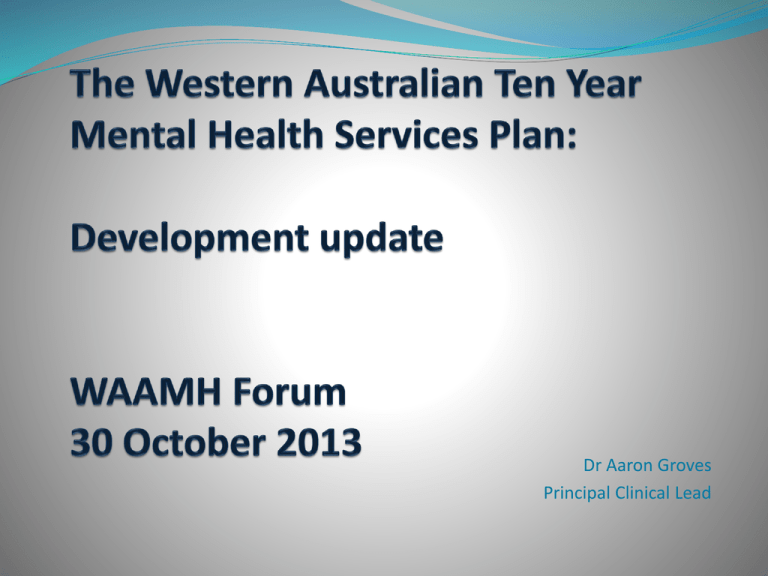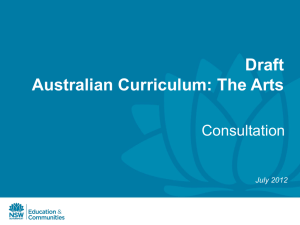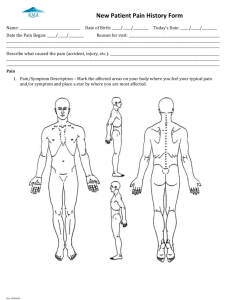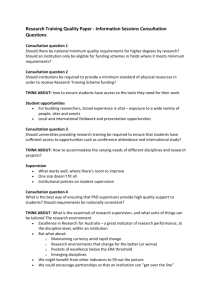Dr Aaron Groves - Western Australian Association for Mental Health
advertisement

Dr Aaron Groves Principal Clinical Lead I acknowledge the traditional owners of the land on which we meet today the Wajuk people of the Noonygar nation, their ancestors and people who have walked the lands before them. I am proud to work, walk and live on their lands WA Mental Health Services Plan Mandate Government requires a Services Plan for mental health services by December 2013 to guide investment decisions that: Responds to the needs of the growing population Embeds the key mental health reform directions Meets best practice standards and resourcing benchmarks Uses evidence based approach Reflects the unique needs of the State Informs funding model development WA Mental Health Services Plan – Project Governance Minister for Mental Health Project Sponsor Project Sponsors Commissioner, Mental Health Commission Executive Director Drug and Alcohol Office Director General, WA Health Steering Committee Principal Clinical Planners AOD Steering Committee Project Management Group Bed-Based Consultation Group Community Clinical Consultation Group Community Support Consultation Group Mr Patrick Marwick Dr Elizabeth Moore Mr Joe Calleja Promotion and Prevention Consultation Group Professor Mike Daube Consumers , Families and Carers Reference Group Alcohol and Other Drugs Working Group Mr Neil Guard WA Mental Health Services Plan WA levers for change Mental Health 2020 The Plan will support implementation of the directions outlined in ‘Mental Health 2020: making it personal and everybody’s business’ which include a greater focus on individualised supports for people, improved coordination and more balanced investment across the mental health sector Stokes The Plan is being developed as part of the WA Government’s response to recommendations from the ‘Review of the Admission or referral to and the discharge and transfer practices of public mental health facilities /services in Western Australia’ (Stokes 2012) WA Mental Health Services Plan Western Australian Drug and Alcohol Planning In line with recommendations from the Stokes Review regarding the need for improved collaboration between mental health and alcohol and other drug services and the government’s announcement to amalgamate the MHC & DAO the plan will incorporate alcohol and other drug services planning concurrently being undertaken by the Drug and Alcohol Office. National Mental Health Strategy • In part an acknowledgement of the broader national health reform agenda, including: Mental Health Reform agenda and commitment to National Mental Health Services planning National Mental Health Policy 1992 National Mental Health Plan, 1992–98 • Medicare Agreements 1993-98 Second National Mental Health Plan,1998–03 • Australian Health Care Agreements 1998-03 National Mental Health Plan 2003–08 • Australian Health Care Agreements 2003-08 COAG National Action Plan for Mental Health 2006-11 National Mental Health Policy 2008 Fourth National Mental Health Plan 2009-14 States and Territory mental health policies, plans and strategies Current State plans exist in Victoria, NSW, SA, Queensland, ACT and Tasmania. The last endorsed WA MH Plan was in 1996. Fourth National Mental Health Plan Action 16 in the Fourth National Mental Health Plan: An agenda for collaborative government action in mental health 2009-14 • Action 16: Develop a National Mental Service Planning Framework that establishes targets for the mix and level of the full range of mental health services, backed by innovative funding models. This action is considered one of the foundation actions of the • 4th plan and the Commonwealth provided $2 million to NSW and Qld Governments to develop the framework in collaboration with all jurisdictions The project is known as the National Mental Health Service Planning Framework (NMHSPF) National Mental Health Service Planning Framework Key objectives • Nationally consistent - an ‘Australian Average’ estimate of need, demand and resources • Flexible and Portable - to suit jurisdictional priorities and other variations in a user friendly format • Not all, but many - will not account for every circumstance or service possibly required • Not who, but what - will capture the types of care required, but will not define who is to deliver • Includes intersectoral linkages with housing, employment and education • Evidence & Expertise - identify what services ‘should be’ provided underpinned by evidence NMHSPF adapts MH-CCP (“muck up”) POPULATION AND EPIDEMIOLOGY DEMAND SERVICE MAPPING CARE RATE CARE PACKAGES RESOURCE PREDICTIONS OUPUT PREDICTIONS STAFF PREDICTIONS AND COSTS F NMHSPF POPULATION EPIDEMIOLOGY PREVENTION Concept of prevention CARE Concept of mild illness Concept of moderate illness Concept of severe illness • Standard reference epidemiology, Australian Burden of Disease 2007 • Stratified by Severity MILD/ MODERATE/ SEVERE Prevalence Age 0-17 Age 18-64 Age 65+ All Ages WELL 84.6% 81.6% 85.2% 82.8% AUS Pop 2011 WELL Age 0-17 4,302,811 Age 18-64 11,551,923 Age 65+ 2,621,864 All Ages 18,476,597 MILD 8.8% 9.9% 7.9% 9.4% NMHSPF MODERATE 4.4% 5.0% 4.1% 4.8% SEVERE 2.3% 3.5% 2.8% 3.1% MILD MODERATE SEVERE 446,133 224,704 115,348 1,405,930 710,775 489,770 242,769 126,443 85,463 2,094,832 1,061,922 690,581 ILL 15.4% 18.4% 14.8% 17.2% TOTAL 100% 100% 100% 100.0% ILL TOTAL 786,186 5,088,997 2,606,475 14,158,397 454,675 3,076,539 3,847,336 22,323,933 • Standard reference epidemiology, Australian Burden of Disease 2007 • (Detailed prevalence of demand by Dx and severity for each age group, eg 18-64) NMHSPF AGES 18-64 (Demand, Numbers, AUS, 2011) Dx=PRIMARY Diagnosis (MI) J02 Schizophrenia J04 Bipolar Disorder J03 Anxiety/Depression J05 Personality Disorder, isolated J06 Anorexia Nervosa J06 Bulimia Nervosa J07a ADHD SMHWB(C&A) - Balance Subtotal (Dx of Primary MI) Dx=PRIMARY Diagnosis (non-MI) J07b Autism - Excess over K09 J07b Asperger’s Syndrome + PDD (nos) K01 Dementia - BPSD K09 Intellectual Disability-MI J01a Alcohol-MI J01b Heroin-MI J01c Benzodiazepines-MI J01d Cannabis-MI J01e Stimulants-MI Subtotal (Dx with MI Concurrent) Dx (N) 85,200 91,288 1,670,300 401,466 10,929 10,673 14,966 2,284,822 Dx (N) 44,498 17,392 10,140 303,714 898,997 49,924 52,625 252,434 72,773 1,702,498 TOTAL MI TREATMENT DEMAND for NMHSPF Tx-MI(N) 85,200 91,288 1,097,625 245,697 10,164 9,926 9,835 1,549,736 Tx-MI(N) 7,594 4,315 63,950 82,708 13,451 9,683 23,224 6,695 211,619 Tx-MILD(N) 477,228 129,807 4,276 611,312 Tx-MILD(N) 3,302 1,521 27,804 35,960 5,848 4,210 10,097 2,911 91,653 Tx-MOD(N) 381,783 103,846 3,060 2,988 3,421 495,098 Tx-MOD(N) 2,641 1,416 22,243 28,768 4,679 3,368 8,078 2,329 73,522 Tx-SEV(N) 85,200 91,288 238,614 12,044 7,104 6,937 2,138 443,326 Tx-SEV(N) 1,651 1,378 13,902 17,980 2,924 2,105 5,049 1,455 46,444 1,761,355 702,965 568,620 489,770 The National MH planning framework methodology can give us a WA Framework that does the following: Enables us to do State-wide population based planning to determine the evidence based ‘blue print’ for Mental Health services into the future including: The detail for the mix and level of services including taxonomies and facilities guidelines The detail for the mix and level of services including standards, care packages & pathways Informing costing for example cost benchmarking; cost weights; activity based funding models WA Mental Health Service Plan WEEK 8 this week and counting down … Service Mapping completed and modelling work commenced Steering Committee & Consultation groups(CG) have met regularly since August and provided with policy context, rationale for national mental health services planning and scope of the work being undertaken CG Provided with an overview of the process for development of the National Framework and definitions and endorsed the process Models of service have been reviewed and recommended Groups have been provided with the key aspects of the methodology for development of the WA Framework and will be provided with a summary of the current WA estimates produced by the model at the next meeting A series of targeted forums are underway to ensure consideration of populations with unique needs, including consumers, carers and family members ,Aboriginal communities, people living in rural and remote areas, multicultural and youth Online feedback survey is available on the MHC website To Deliver … WA Mental Health Services Framework Applies National Mental Health Services Planning Framework to inform and determine the type/quantity of services required for WA Maps existing services Identifies gaps and imbalances Informs and aligns with the WA Health Clinical Services Framework The WA Mental Health Services Plan Will assist in developing strategic directions and priorities based on demand modelling and expert opinion, balancing short and long terms goals, and ensuring appropriate resource application Will describe key demand drivers for future mental health service planning in WA and apply them to the WA context to predict future requirements Will not seek to specify how services will be delivered at a local level – further consultation and consideration of local issues and services is required to determine how to best deliver services at a local level QUESTIONS











